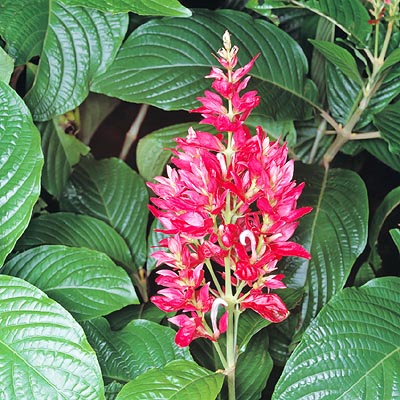Family : Acanthaceae

Text © Pietro Puccio

English translation by Mario Beltramini

Showy 30 cm inflorescences with red purple bracts © Giuseppe Mazza
The name of the genus is the combination of the Greek words “mégas” = great and “skepasma” = covering, coat; the name of the species is the combination of the Greek words “erythros” = red and “chlamys” = cloak, with reference to the bracts inside which the flowers originate.
Common names: “Brazilian red cloak”, “Brazilian plume”, “red justicia” (English); “Fackelbusch”, “Fackel-busch” (German); “justicia rouge”, “manteau rouge du Brésil” (French); “canutillo”, “pavoncillo rojo” (Spanish); “justicia-vermelha”, “capota-vermelha” (Portuguese).
Evergreen semi-woody shrub which can reach a height of 2-3 metres, with ovate leaves, long up to 30-35 cm and 10-15 cm broad, of a glossy pale green colour with evident veins. The inflorescences are terminal, long about 30 cm, made by bracts long about 4,5 cm and 2 cm broad, of a colour going from the intense pink to the red purple, in which interior come out small white, or pale pink, bilobate, tubular flowers; the bracts persist for about two months, whilst, in the Tropics, the blooming goes on for a good part of the year. The fruits are clavate, long 35 mm and 8 wide, containing a maximum of 4 seeds. It reproduces by seed and by semi-woody cutting in summer.
Plant of remarkable ornamental value due to its great leaves and the showy inflorescences, cultivable in open air only in the tropical and subtropical areas, as it is a plant rather sensitive to the low temperatures, as a matter of fact, the aerial part is already seriously damaged with temperatures close to 0°C. It needs rather vast spaces, in order to get the best advantage, and a position slightly shaded; it is not particular to the soil, provided the same is well drained.
